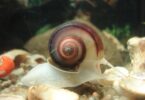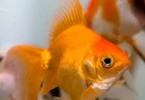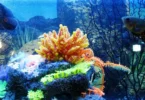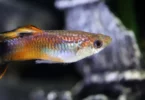Last Updated on February 10, 2023 by Matt
BUTTERFLY FISH: BACKGROUND INFO & OVERVIEW
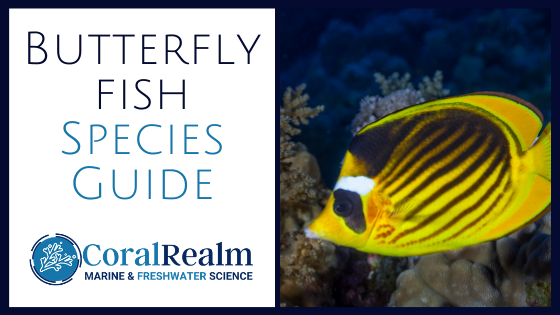
For any aquarist looking for something unusual and out of the ordinary for their fish tank, the butterfly fish could be an option. We must point out that, like Betta fish, Butterfly fish have specialized requirements for diet and water quality. Novice aquarists are therefore discouraged to keep these fish without dedicated preparation and the acquisition of detailed knowledge. Here’s a quick stat of this beautiful fish:
| Butterfly Fish | Description |
|---|---|
| Origin: | Indonesia, Africa, Tahiti, Fiji, Hawaii, Maldives |
| Lifespan: | 4 – 9 Years |
| Diet: | Omnivore/Corallivore |
| Species: | Chaetodontidae |
| Color Form: | Primarily Yellow, Blue, Black, Orange & White |
| Temperament: | Peaceful |
| Average Size: | 8 inches |
| Water Conditions: | 72-78°F, dKH 8-12, pH 8.1-8.4 |
| Minimum Tank Size: | 130 Gallons |
| Tank Conditions: | Not Reef Compatible |
| Compatibility: | Clownfish, Damselfish and Tangs |
| Environment: | coral reefs, mudflats, seagrass beds and lagoons |
If you have experience of keeping a saltwater aquarium, you will be in a good position to expand your knowledge to include Butterfly fish.
Scientifically known as Chaetodon, Butterflyfish belong to the Chaetodontidae family. The Chaetodon is the largest subsection or genus of this Chaetodontidae family. Coral fish and Banner fish also belong to this family.
Butterflyfish are small to medium sized marine fish. Their size ranges from approximately 4.5 to 8.5 inches in length, although some species reach larger adult sizes. In the wild, Butterflyfish are found predominantly within the coral reefs of the Pacific, Atlantic and Indian Oceans, both in tropical and subtropical waters
Butterflyfish are awake during daylight hours, during which time they feed and graze. They rest during the nighttime. They are therefore categorized as diurnal.
APPEARANCE – COLORING, MARKINGS AND SHAPE
Whilst the freshwater species of Butterflyfish are dull in color, the majority of the saltwater, coral reef dwelling varieties are striking in both color and pattern. With background colors of yellow, red, blue and orange, many have intricate markings and patterns. With their intense colors, Butterfly fish really do make a wonderful addition to any aquarium. These are beautiful fish that represent the typical coral reef scene; absolutely stunning.
Some have dots on their sides which look remarkably like eyes! This is simply to confuse predators – which end do they attack, and in what direction will the Butterfly fish escape?!
Strangely, young juvenile butterflyfish have different markings to those displayed by adult fish.
Many species of Butterfly fish have a similar shape to Angel fish, their equally striking relations; with very narrow, disc shaped bodies. They appear compressed in the side to side aspect; the idea of this shape is to enable them to move quite freely between the narrow spaces between corals. This is important as they forage for food in the wild environment of the coral reef.
AQUARIUM REQUIREMENTS AND ENVIRONMENT NEEDS
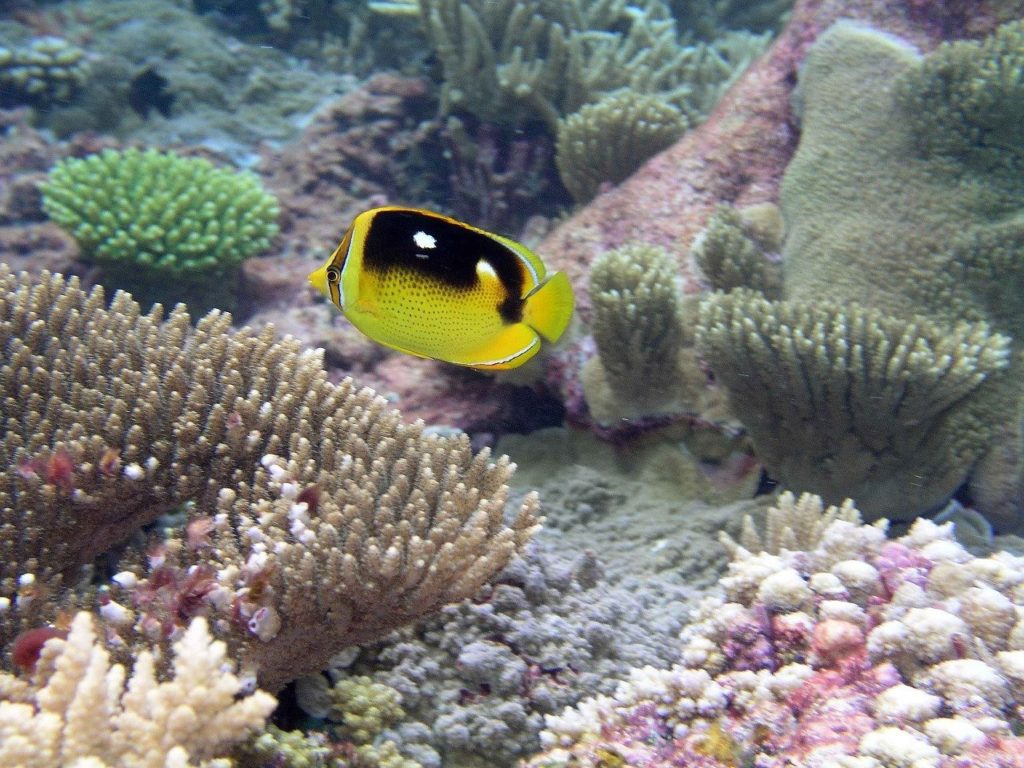
There are a minimum of 114 species of butterflyfish, and the vast majority are saltwater species. Not all saltwater butterfly fishes are suitable to be kept in aquaria; as stated, their requirements are precise and not for the novice fish keeper. For example, the chevroned Butterflyfish, known as Chaetodon trifascialis, does not adapt well to the captive aquarium environment.
Butterfly fish need to be kept in a stable environment in terms of water quality. They should not, therefore, be put into a newly set up aquarium. An existing, mature tank with stable water conditions is a necessity.
When water conditions deteriorate, the Butterflyfish also deteriorate. They can quickly lose their appetite and become quite sluggish and lethargic.
Butterflyfish need large aquariums which provide them with both hiding spaces and nooks and crannies to graze and search for food. A large aquarium will also give them the space they need to swim.
For information on the requirements for your specific species, please refer to the table of Species of Marine Butterflyfish below.
So whilst their beautiful appearance makes a tempting addition to a saltwater reef tank, please do ensure that you are fully prepared to provide an appropriate environment for these fish.
SPECIES OF BUTTERFLYFISH BEST ABLE TO ADAPT TO AQUARIUM LIFE
Klein’s or sunburst butterflyfish, scientifically known as Chaetodon Kleini, and the Racoon butterflyfish, known as Chaetodon Lunula, are quite adaptable. These species are relatively easy to look after, and are more tolerant to the tank environment.
The Sunburst butterflyfish is a really beautiful fish with a striking, predominantly yellow, coloring. It is also known as the Blacklip Butterflyfish on account of the black colouration around the mouth. Whilst mainly bright yellow, it has white and black striped markings towards the head region.
BUTTERFLYFISH BEHAVIOR, HABITS AND COMPATIBILITY
The smaller butterflyfish tend to swim in groups or schools, whereas the larger species tend towards a solitary existence or seek the companionship of a mate. Having found a mate, Butterflyfish will remain in the pairing for life.
Butterflyfish are extremely agile; they can swim and change direction very quickly. Useful when avoiding becoming prey to larger, more aggressive fish. Rather like the Parrot fish, the butterflyfish swims by using synchronized rowing strokes of its pectoral fins. As with a sailing vessel, the tail fin is used in the same way as a rudder to maintain direction and balance.
Due to their flattened bodies, they are able to slip into crevices within the coral of their natural environments. This enables them to exploit all the nooks and crannies of the coral in order to both find food and escape predation.
The majority of butterflyfish are peace loving creatures. Generally speaking, they make good tank companions if they are given the right conditions. They will need an aquarium of sufficient size to enable them to distance themselves from other fish when needed. Good planting and sufficient hiding places are very important to ensure harmony within the aquarium.
Butterflyfish are general non aggressive and tolerant of other species. They mix particularly well with Tangs which belong to the Acanthuridae family. Butterflyfish can also cohabit with Parrotfish, Clownfish and Gobies which are marine fish ideal for the community aquarium.
For care, behavior, size and habitat details for individual species of Butterflyfish, we have created a comprehensive table below.
SPECIES OF MARINE BUTTERFLYFISH
| Butterfly Species | Description |
|---|---|
| Auriga Butterflyfish/Threadfin Butterflyfish | A popular butterfly fish, that like all species is peaceful and hardy. They are one of the more shy species, and should have lots of live rock to hide in. These fish prefer a diet of high quality protein, and lots of it. Think fish meat, crustacean meat, and mysis shrimp in droves. They are easy to care for, have a peaceful temperament and need tank conditions of: 72-78OF, dKH 8-12 and a pH of 8.2-8.4 |
| Copperband Butterflyfish | The Copperband Butterflyfish is also known as the Beaked Butterflyfish or Beaked Coralfish is native to Australia, Indonesia, Philippines, Singapore. It possess a long snout, and the narrow mouth is used for hunting food in coral and rock crevices. This particular species of Butterflyfish has distinct yellow and orange bands with a black line along the edge. At the rear, on its dorsal fin, there is a large fake eyespot that was developed to deter predators, making it easy to identify within the butterfly fish group. In a tank environment, it needs to be kept in large reefs, ideally 140 gallons or more. It should be kept with only other Copperbands, and be careful with reef aquariums as they picked on anemones. Not to be kept with wild, rapid or stress inducing species. It’s a hard fish to keep because of its picky feeding nature. You’ll need to try a variety of foods to get it to feel comfortable. |
| Falcula Butterflyfish | Native to the maldives, the Falcula Butterfly fish, aka the Sickle Butterflyfish, is mostly white on its body, with a yellow fin. A more aggressive species, this fish can reach 8 inches in length and needs at least 130 gallons to feel happy. Keep this fella with large fish and other butterflies is a good way to go. This species will without doubt snack on anemones, hard corals, and mushroom anemones causing problems in a reef aquarium if you’re worried about damage to your reef. Minimize damage by feeding it meaty foods like all butterflies. Go with crustacean flesh, lots of mysis shrimp or frozen marine foods. |
| Fourspot Butterflyfish | Found almost exclusively on rough, further out seaward reefs. Distributed from Hawaii to the Marshalls in Micronesia. Best kept in large calmer fish aquariums, ideally fish only. The large tank should have plenty of open swimming space, aquarium live rock, nooks and hiding places, and having some micro and macro-algae growth in the tank. As to diet, a meaty diet of live foods similar to the others is great. According to some, these guys love fortified brine shrimp and/or black worms to get them feeding in a tank. Once feeding regularly, you can switch to frozen meaty foods such as mysis, and other meaty foods. In the wild, it feeds on algae often so Spirulina flakes can also be given, along with high algae content flake food. |
| Klein’s Butterflyfish | Native to indonesia, and reaching around 6 inches in length. The Klein’s Butterfly fish, aka the Orange Butterflyfish, also known as the Sunburst is a bright gold and yellow fish in this sub-genre. Should be kept in a large tank, but given it’s around 2 inches smaller than its peers, you could get away with a tank of around 120 gallons. If you want to keep with other butterflies, introduce them at the same time to establish territory. Easily looked after, hardy and strong. Probably best kept in a (FOWLR, fish only with live rock tank). Diet for this guy consists of lots of food three times a day. Think fish, crustaceans food, again lots of mysis shrimp, and frozen marine preparations. It needs to be fed at least three times daily. |
| Lemon Butterflyfish | Native to hawaii and reaching about 5 inches in length. The lemon Butterfly has a variety of different names it can go by; including the millet, or milletseed butterflyfish. Being one of the smaller Butterfly fish, the milletseed can get by in a 100 gallon tank. These are fast swimmers, so try not to keep them in a tank smaller than that. They have a distinctive yellow color, with a bold spots forming a stripped effect. They can be kept in pairs, but are also happy on their own. If in pairs, introduce them at the same time. Diet should be fine food, given the fishes size. That’s relative of course, just chop the meat more than you normally would. Crustacean marine meat, mysis shrimp and even vitamin enriched foods and suitable to keep that lemon vibrance. |
| Lined Butterflyfish | Native throughout the pacific. This is a very widespread butterfly fish geographically. It’s a sensitive fish, with finer fins than most. It shouldn’t be considered delicate by any means, as it’s survived in multiple regions throughout the vast pacific ocean; and can reach a large size of nearly 12 inches. Recommend for experts in a very very large tank. |
| Pearlscale Butterflyfish | This particular species of Butterflyfish is particularly beautiful; with a pearl white body true to its name. The fish looks particularly stunning under Aquarium LEDs as it shines and makes the fish brighter. A perfect addition to a FOWLR tank, the fish is peaceful and will nibble at coral. |
| Pebbled Butterflyfish | This species of Butterflyfish is a prolific Coral polyp consumer. Keep with lots of live rock, and shelter for this fish to sleep and hide in. |
| Pyramid Butterflyfish | Native to Hawaii, Indonesia, New Caledonia and reaching 7 inches in length. The Yellow Pyramid Butterflyfish aka the Yellow Zoster Butterflyfish, is prevalent throughout the indian ocean. And is in huge numbers thought Indonesia. With yellow fins, and a white body, it’s distinctive and medium size. The black head is for camouflage against the white sand and dark reef rock. The Pyramid Butterfly Fish feeds more on plankton than it does on corals, so it’s much more suited to a reef tank. However, lots of live rock should be present in the tank. Due to its relatively large size, keep in a tank at least 130 gallons in capacity. Its diet should be frozen/or freeze dried food. Since this is less of a meat eater, those containing algae are more suited. A heavy mysis shrimp diet, supplemented with dried algae is a great combo for this grazing fish. |
DIET AND FEEDING REQUIREMENTS OF BUTTERFLY FISH

To reiterate – butterfly fish are sensitive fish that have very specific needs. This includes their dietary requirements. It can be a difficult job for the aquarist to ensure that their butterfly fish feed well. It is worth taking time to experiment with different types of food so that you understand your fishes’ preferences. Generally known as omnivores which eat both vegetation and small creatures and invertebrates, your butterfly fish will have their individual preferences.
Some species of Butterfly fish are grazers. These species will need plenty of live rock and even corals to satisfy their grazing habit. They will appreciate algae to graze upon as well. Other butterfly fish enjoy a diet rich in live feed and plankton.
These coral reef Butterfly fish have long snouts which they use to good effect to gain access to cracks and crevices in the coral reefs. They push their snouts into the cracks in the reef to graze on algae, coral polyps, and invertebrates like sponges.
We would suggest taking time to study the fish and observing them eating prior to actually buying them. If they are feeding well, request details of their diet from the seller. You can then continue to give them what they have become accustomed to, providing consistency and continuity in the aquarium environment.
You can also try younger fish with live brine shrimp which are a very popular food choice in the marine aquarium. Brine shrimps are tiny crustaceans that live within saltwater habitats. Live feed such as the brine shrimp will often enhance the beautiful colours of your Butterflyfish. You can easily purchase live brine shrimp, so it’s a viable option.
Frozen foods can also be considered, such as frozen brine shrimp. Your butterflyfish will pick at the frozen food if it floats on the surface or as it starts to descend through the water; however, it will probably ignore anything that settles on the substrate.
Flaked foods and seaweeds can also be considered as part of a varied diet. Take time to see how much and how quickly your Butterflyfish feed, so that you can give the correct amount at each feeding session. Your fish will need to be fed several times daily, but only an amount that satisfies their need at each sitting.
GENERAL CARE OF YOUR BUTTERFLY FISH
These delicate fish need good, consistent water quality. Any deterioration in the water quality will quickly give rise to health problems for your Butterfly fish.
Butterflyfish are perfectly adapted to life in the marine coral reef, and are consequently difficult to adapt and thrive in a captive aquarium environment. General rules for the care of Butterfly fish are difficult to provide, as the necessary care is species specific; different species require different conditions. Be careful, therefore, when combining different species in the same tank. Ensure that their requirements are the same, or they will fail to thrive.
As previously stated, Butterfly fish will fare better in a well established aquarium with stable water quality. As stated, there are only a few rules that are common to all Butterfly fish :
- The water should be slightly acidic and soft
- The temperature should be in the range of 75-80 degrees
- Introduce into an established aquarium which will provide grazing opportunities
- Ensure the aquarium is well lit
- Provide plenty of interesting planting and hiding place
- Use non-metallic equipment in a Butterflyfish marine/salt water environment
There are certain health problems that commonly arise for Butterfly fish when the water quality declines. This includes, but is not restricted to, dropsy or ascites and nitrite poisoning.
DROPSY
Dropsy/ascites is the result of a bacterial infection. The main symptom is swelling of the abdominal region. Ascites can be difficult to cure if it’s not caught early.
Given the cause of this problem is water quality decline, prevention is better than cure. Consider the use of an ultra violet steriliser to assist in maintaining water quality.
If your fish do suffer from drospy, restore the water quality as quickly as possible, maintain it as such and give a good diet.
Within an aquarium environment, the density of the fish population in the volume of water will inevitably be higher than that found in nature. This will create imbalances, with seemingly clean water actually having levels of nitrite or ammonia that are too high to maintain fish health.
As soon as fish are introduced into an aquarium, the water quality will be affected. Fish excrete waste material. Uneaten food will drop onto the substrate at the bottom of the tank. Additionally, the planting required to provide the fish with the environment they need will add to the detritus layer at the bottom of the tank through the shedding of dead leaves etc.
Bacteria break down this detritus. This is true both in nature and in the aquarium. There are a range of processes by which bacteria break down these waste products. The sum/combination of these processes is known as the Nitrogen Cycle.
The waste excreted by the fish themselves together with decaying plant matter produces ammonia. Ammonia poisoning in fish is a highly toxic compound. Ammonia is converted into nitrites, which is also a highly toxic substance. Nitrites are subsequently converted into nitrates which, by comparison, are benign and harmless; although long term, high levels of nitrates can be injurious to your Butterfly fish.
This Nitrogen Cycle will go on continuously within any aquarium, but to prevent problems you need to invest in a good mechanical filter. Again, prevention is better than cure.
FRESHWATER BUTTERFLY FISH
The African Butterfly fish, known scientifically as Pantodon Buchholzi in the Pantodontidae family, is a dull coloured, freshwater species of Butterfly fish. This African Butterfly fish is not very closely related to the brightly coloured saltwater varieties, which some aquarists may prefer for their aquarium.
The African Butterfly fish is a surface dwelling predator. It will make an attempt at any insect, or indeed any smaller fish, that can fit into its large mouth. In spite of this omnivorous habit, the African Butterfly fish makes a great tank companion to fish larger than three inches in size. Ideally, these other fish should be middle or bottom tank dwellers, and be peaceful in temperament. This will create harmony and interest in the aquarium.
If these freshwater Butterfly fish are kept as a single species group and are not kept alongside other fish species, then the tank does not have to be very deep. In fact, a depth of approximately 8 inches will suffice. Obviously a deeper aquarium is required if the Butterfly fish are kept with other species which are middle and/or bottom dwellers.
This species of Butterfly fish will thrive in water that is well filtered and soft. These fish will suffer as a result of any deterioration of water quality. Loss of appetite and problems with the appearance of the fins will probably be a sign of poor or declining water quality.
Butterfly fish love to jump! Whether this be for fun or in pursuit of prey, they are agile jumpers! With this in mind, flies are an excellent food source, providing both nutrition and the natural method of hunting. Butterfly fish are programmed to jump for prey, and it’s good for them to emulate this natural instinct within the tank environment.
So although the African Butterfly fish is plain in colour, it has really interesting instinctive habits that make it a great addition to an aquarium.
A butterfly fish tank will need to have a surface layer of floating plants. As well as floating live planting, cork bark can be used. This is a floating bark upon which you can place a small receptacle with maggots. When the maggots hatch, the Butterfly fish will literally leap into action! This will provide excellent nutrition and stimulation.
Apart from maggots and flies, other favourite fresh foods include woodlice and mealworms. Butterfly fish eat insects that live on the surface of the water, whether they be in larval or adult form. As mentioned, maggots are a favourite. Maggots are the larval stage of the housefly, and can be bought from fishing stores. Store them in a sealed container that has small air holes; small enough to avoid escape, but sufficient is size to allow for good ventilation. Make sure that you store them at room temperature, away from direct sunlight.
Regarding purchased fish food, Butterfly fish enjoy large flake fish food or pellets that float on the surface. As surface feeders, these butterfly fish will usually ignore anything that ends up on the bottom of the fish tank.
CONCLUSION – HOW SUITABLE ARE BUTTERFLYFISH FOR YOUR AQUARIUM?
As with Betta Fish and other sensitive species, the Butterflyfish will only thrive in captivity if you research the breed carefully. Just because you find them available for sale in aquarium outlets, it does not mean that they are suitable types for captivity.
Only select butterflyfish that are known to cope with an aquarium environment. Ensure also, that if you mix the types, they have the same basic needs.
Marine butterflyfish are stunning, with striking colours and markings, and they make for a fantastic aquarium. However, as responsible aquarists we must provide them with the appropriate environment.
Study their feeding habits and preferences, both before and after you buy or acquire them. Offer a range of foods to assess suitability.
Ensure that your water quality is stable, and refer to the Butterflyfish Species table above.
For freshwater aquarists, the butterflyfish known as Pantodon Buchholzi makes a really interesting addition to the tank. Although it does not have the striking bright colours of the marine butterflyfish and is indeed a different species altogether, it has interesting habits.
It is a surface dweller and mixes well with peaceful companions who dwell in the middle of bottom zones of the aquarium.
So, in conclusion, if you do your research and pay strict attention to your water quality, you should be able to enjoy the aesthetic value that butterflyfish will contribute to your aquarium.


